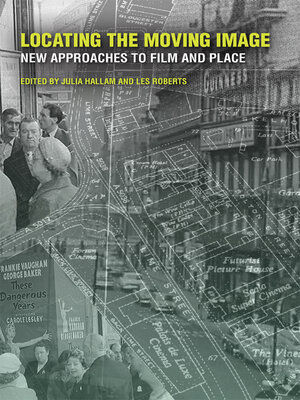Locating the Moving Image
ebook ∣ New Approaches to Film and Place · The Spatial Humanities
By Julia Hallam

Sign up to save your library
With an OverDrive account, you can save your favorite libraries for at-a-glance information about availability. Find out more about OverDrive accounts.
Find this title in Libby, the library reading app by OverDrive.



Search for a digital library with this title
Title found at these libraries:
| Library Name | Distance |
|---|---|
| Loading... |
Essays exploring the methodologies used by film scholars to develop a spatial history of the moving image.
Leading scholars in the interdisciplinary field of geo-spatial visual studies examine the social experience of cinema and the different ways in which film production developed as a commercial enterprise, as a leisure activity, and as modes of expression and communication. Their research charts new pathways in mapping the relationship between film production and local film practices, theatrical exhibition circuits and cinema going, creating new forms of spatial anthropology. Topics include cinematic practices in rural and urban communities, development of cinema by amateur filmmakers, and use of GIS in mapping the spatial development of film production and cinema going as social practices.
"Introduces some of the concrete ways practical mapping and GIS technologies help elaborate historical film projects. . . . The scope of many of these projects is breathtaking in scale. . . . Others embrace ethnographic methods that tell poignant individual stories. Still others deftly merge qualitative and quantitative approaches. . . . As a whole, the volume brings together disparate fields of study in interesting ways." —James Craine, California State University, Northridge
"This collection breaks new ground for cinema history. Hallam and Roberts have gathered some of the foremost scholars who are mapping spatial histories of the moving image and the geographies of film production, distribution and consumption. Introducing new interdisciplinary methods and asking new questions, Locating the Moving Image takes film studies into new territory, beyond the boundaries of the text and its interpretation, towards an understanding of the relationship between culture, spatiality and place." —Richard Maltby, Matthew Flinders Distinguished Professor of Screen Studies, Flinders University
Leading scholars in the interdisciplinary field of geo-spatial visual studies examine the social experience of cinema and the different ways in which film production developed as a commercial enterprise, as a leisure activity, and as modes of expression and communication. Their research charts new pathways in mapping the relationship between film production and local film practices, theatrical exhibition circuits and cinema going, creating new forms of spatial anthropology. Topics include cinematic practices in rural and urban communities, development of cinema by amateur filmmakers, and use of GIS in mapping the spatial development of film production and cinema going as social practices.
"Introduces some of the concrete ways practical mapping and GIS technologies help elaborate historical film projects. . . . The scope of many of these projects is breathtaking in scale. . . . Others embrace ethnographic methods that tell poignant individual stories. Still others deftly merge qualitative and quantitative approaches. . . . As a whole, the volume brings together disparate fields of study in interesting ways." —James Craine, California State University, Northridge
"This collection breaks new ground for cinema history. Hallam and Roberts have gathered some of the foremost scholars who are mapping spatial histories of the moving image and the geographies of film production, distribution and consumption. Introducing new interdisciplinary methods and asking new questions, Locating the Moving Image takes film studies into new territory, beyond the boundaries of the text and its interpretation, towards an understanding of the relationship between culture, spatiality and place." —Richard Maltby, Matthew Flinders Distinguished Professor of Screen Studies, Flinders University







